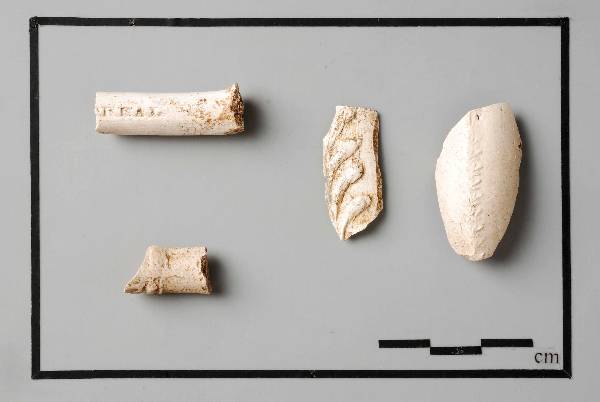The distribution of functional groups reveals a strong predominance of food-related, architectural and unaffiliated artifacts, as well as faunal remains through the A horizon soils and in Feature 2. The A horizon is composed of generalized sheet midden.
Food Related Artifacts
Food-related artifacts at the L. Northrup site consisted of food preparation and storage vessels, food serving vessels, and food-related faunal remains (animal bones). Food storage vessels were the most frequently identified among the artifact assemblage. Of the 3,955 artifacts recovered from the site, 13.5% (N=535) are redware sherds, often lead-glazed redware sherds. Lead-glazed redware was produced mainly prior to 1900. Relatively few stoneware vessel fragments were found. This is in keeping with an early nineteenth century site, where locally made redwares would have been most common for utilitarian wares.
Among ceramic vessels used for food service, ceramics referred to as whitewares (produced from 1830 onwards) and pearlwares (produced ca. 1780-1830) were the most frequently found. Small numbers of creamware (1780-1820), ironstone (1850 onwards), glossy manganese-glazed redware (1750-1900), as well as glass, were also present. Archaeologists also recovered very small amounts of tin-enamel glazed earthenware (1700-1750), the earliest ceramic material found at the L. Northrup site. Vessels forms recovered from the site included ceramic plates, a ceramic soup plate, teacups, saucers, a ceramic teapot, and glass tumblers. These types, materials and forms within the food-related group seem consistent with a diverse midden in the vicinity of an early- to mid-19th century rural farmstead.
The most prevalent types of ceramic decoration at the L. Northrup site are transfer print, shell-edge, and hand painted decoration. All three decoration types became popular with the development of pearlwares in the 1780s and continued in popularity through the first half of the19th century. Transfer print designs on three vessels were identified by pattern type: “Florentine” (vessel 50), “Palestine” (vessel 79), and “Tuscan Rose” (vessel 78). These designs were produced during the first half of the nineteenth century. One molded ironstone pattern was identified, “Baltic,” a pattern registered in 1855 (Dieringer and Dieringer 2001:60). A minimum of one tin-enameled earthenware (Delftware) vessel predates the rest of the assemblage by several decades, and may represent a curated item.
The glass assemblage is mainly composed of unidentified bottles. These include 1 amber bottle, 5 aqua bottles, 3 clear bottles, 3 olive bottles and 1 teal bottle. One of the aqua bottles was molded, one had recessed panels, and one teal bottle was molded. The recessed paneled aqua bottle has a pontil scar on the base, pointing most likely to nineteenth century manufacture, before the invention of automatic bottle machines. None possessed characteristics to tie to a function. Three glass vessels could be identified by function: a clear glass tumbler; a paneled aqua inkwell; and a molded aqua liquor bottle. The aqua liquor bottle (vessel 85) is a pictorial flask, a type generally produced from 1815 to 1870. Base fragments of an aqua pictorial flask (possibly vessel 85), appear to be the “urn with fruit” motif, popular from 1820 to 1850 (http://www.sha.org/bottle/liquor.htm#Figured/ Historical%20Flasks).
Overall, the ceramic and glass vessels recovered from the tested portion of the L. Northrup site show a fairly typical assemblage for an early- to mid-nineteenth century farmstead. Ceramic vessels were in much greater evidence than glass, as is typical before the introduction of automated glassware manufacture. The decorated ceramics at the L. Northrup site included a range of more and less expensive styles. Of the decorated ceramics, the majority were transfer printed and shell-edged wares (30% each). In the second quarter of the nineteenth century, transfer printed wares were a more expensive decoration style, while shell edged were the cheapest decorated tableware available (Majewski & O'Brien 1987; Miller 1980).
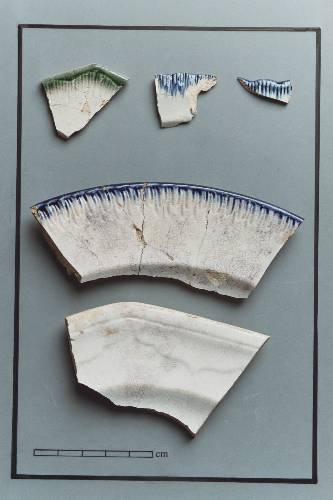
Edged and ironstone ceramics from the L. Northrup site. Top, left to right: Octagonal plate with green scalloped shell edge (Vessel 76); Blue shell edge pearlware plate (Vessel 69); Blue shell edge exterior design, possible cup (Vessel 74). Middle: Blue shell edge whiteware plate (Vessel 70). Bottom: Molded ironstone plate, Baltic shape (Vessel 43).
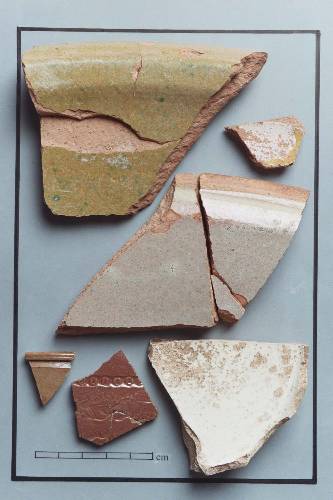
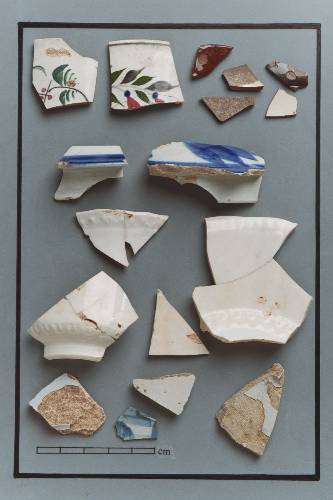
Assorted tablewares and teawares from the L. Northrup site. Top row, left to right: Hand painted tea cup with sprig floral design (Vessel 59); Hand painted tea cup with floral design (Vessel 58); Fine redware with molded rim (Vessel 41); Four fragments white slipped fine redware (Vessel 32). 2nd row: Blue hand painted pearlware lid (Vessel 6). 3rd row, left to right: Porcelain tea cup base (Vessel 80); Porcelain rim (possibly Vessel 80); Porcelain saucer fragments (possibly Vessel 13). Bottom row: Delftware fragments.
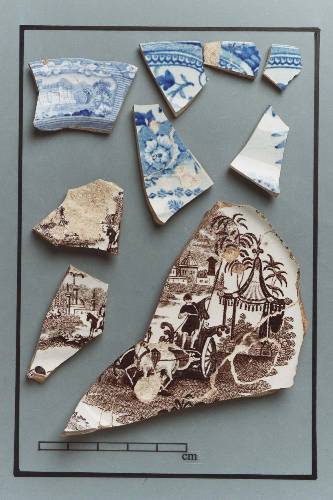
Selection of transfer printed ceramics from the L. Northrup site. Upper left: Blue transfer printed plate, “Florentine” pattern (Vessel 50). Upper right grouping: Blue transfer printed pearlware saucer (Vessel 48). Middle and bottom: Brown transfer printed plate, “Palestine” pattern (Vessel 79).
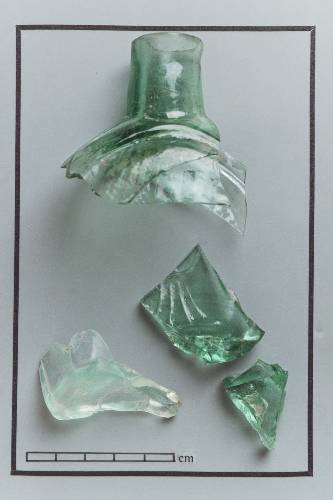
Faunal Remains
Faunal remains likely attributable as food remains include cow, pig, chicken, and sheep/goat (it is very difficult to tell sheep and goats apart by skeletal remains). Other identified likely meat sources include goose (possibly a Canada goose), unidentified fish, and unidentified freshwater mussels. The fish and mussels may have come from nearby Tibbetts Creek. Non-meat animals include bones from two shrews (probably from an excavated nest), a woodchuck, a cat, and a rat.
Cow remains were the most numerous at the site. While a minimal number of two individuals were identified, the bones present may well have come from multiple cows over many years’ time. The bones were examined for age via the developmental state of teeth and bones. This evidence indicated both cows of approximately 18 months of age, and cows aged over three years. The range of ages suggests that some cows were kept for breeding/milking purposes, while others were beef cattle. A minimum of three pigs were present in the faunal remains. One was slaughtered around 8-12 months, a second between 12-16 months, and a third around 17-20 months. This indicates that pigs were likely raised on the site and slaughtered before they grew to an unmanageable size. Skeletal remains strongly suggest a minimum of three sheep or goats in the assemblage, with the average age at death probably between one and two years. The animals may have been raised for a season’s wool or milk production, and then slaughtered for meat.
Butchering marks were observed on 69 of the bones in the assemblage. As is typical of a 19th century site, saws were the most commonly used implement. Saws may have been used by retail butchers or on the farm. Multiple “false start” marks and incomplete cuts may be interpreted as signs of inexpert butchering, and were observed on two specimens. A seemingly machine-cut specimen, suggesting professional butchering, was also present in the assemblage. A heavy chopping tool, such as an axe or cleaver, was clearly used on six specimens, and may have been used on two others (including a goose wing joint). Chopping suggests home butchering, since it is an inefficient way to dismember a carcass relative to the use of a saw.
Architectural Artifacts
Artifacts related to building structures were composed mainly of window glass and cut nails. The dominance of cut nails would be consistent with the early- to mid-19th century occupation. Small numbers of wire nails and undiagnostic nails were recovered from the general sheet midden. Only cut nails were recovered from Feature 2. If artifacts from Feature 2 are added to the totals, amounts of architectural artifacts become noticeably higher in Units 6 and 7, suggesting that architectural remains may be concentrating to the south-southeast of Feature 2, but this cannot be definitively determined within the current project boundaries.
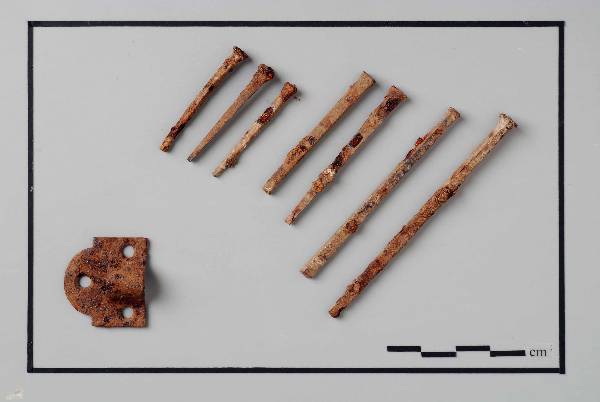
Agricultural
Some artifacts at the L. Northrup site point to the former inhabitants’ agricultural pursuits. Archaeologists recovered one horseshoe nail and numerous fragments of redware milk pans. A total of 173 redware fragments were identifiable as broken pieces of milk pans. From these, a minimum of four individual milk pans were identified in the vessel analysis. The number represented in the sample may have been higher. Lead-glazed milk pans would have been used before 1900 in milking cows. The concentration of milk pan fragments in the front yard setting may indicate an activity area on the farm property.
Clothing and/or Hygienic
Small numbers of personal items, toys and clothing items were found at the L. Northrup site. Artifacts such as these often bring a more personal view of the site’s inhabitants. Clothing-related artifacts found at the site included a shoe grommet, four buttons and a thimble. The thimble is evocative of the mending, sewing and quilting work women would have performed at the L. Northrup site. A large white clay marble provides a glimpse into children’s play activities in the nineteenth century. Fragments of two chamber pots (one blue transfer-printed pearlware and one yellowware) demonstrate nineteenth century hygiene practices. An aqua glass inkwell and a ferrous metal bell were also found during the excavations. Ten gun cartridges located in the excavations highlight the rural location of the site.
Later 19th century and 20th century artifacts (a plastic chess piece, glass marbles, clip-on earring and 1964 nickel) were found at the western end of the excavation area, nearer to the current building entrance and the driveway/parking area.
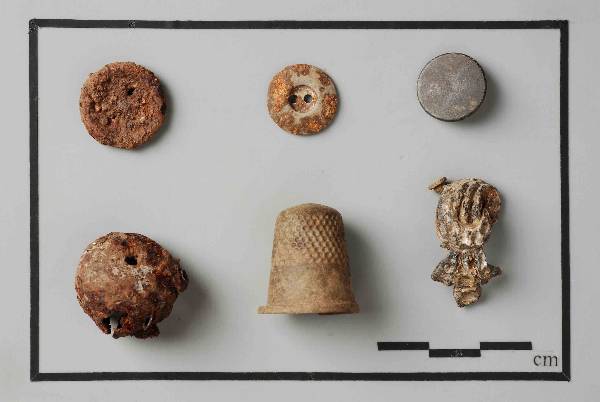
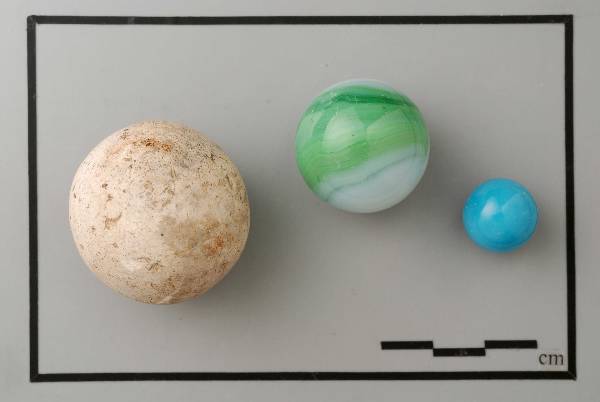
Tobacco-Related Artifacts
Thirteen smoking pipe fragments point to the common practice of tobacco use at the L. Northrup site. The fragments include 12 kaolin pipe fragments and one red clay pipe stem fragment. While white ball clay was the most common material for pipes, red clay was not uncommon (Bradley 2000:108). One pipe stem fragment was stamped, with the remaining portion reading “HEN.../...REAL, ” likely a mark for the Henderson Company in Montreal, Quebec, in operation from 1847 through 1876 (Bradley 2000:117). Though four of the pipe fragments have molded designs, the fragments are too small for any in-depth analysis of the design elements.
